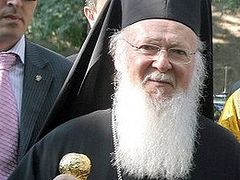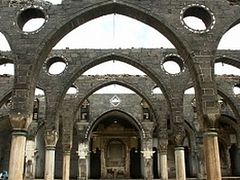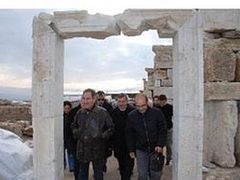Source: BBC
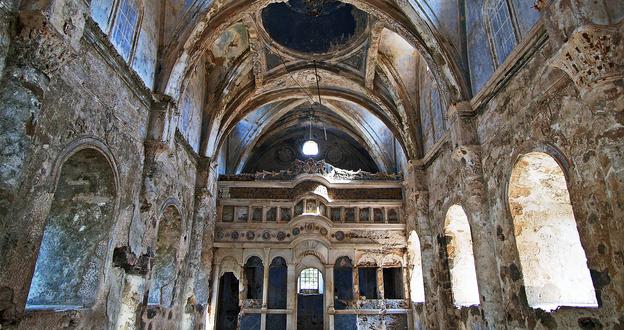 Kayakoy's Kato Panagia is a shell of its former grandeur. (Julian Kaesler/Getty)
Kayakoy's Kato Panagia is a shell of its former grandeur. (Julian Kaesler/Getty) Few independent tourists make their way to Kayakoy, a ghost town just 5km west of the tattoo parlours, British pubs and dance clubs of Hisaronu, a raucous tourist resort on Turkey’s southwest coast. The abandoned village’s air of mystery – and off-the-beaten-path feel – is precisely what drew me.
In the past thirty minutes, I had climbed half a kilometre or so up the steep incline of the hillside village, and was still only halfway to the summit. Stumbling over broken stone steps and weed-strewn paths, past pomegranate, pine and fig trees, I paused to survey the skeletons of three or four hundred stone houses, now bathed in a honeyed evening light. From the inhabited valley floor, far below, I could hear the strains of a mournful Turkish melody that recalled ballads I had heard in Greece.
I sipped the last of my water and continued the upward trek, my face dripping with perspiration. Finally, after another half kilometre, I was rewarded. On the other side of the slope, just around the bend from the famed lagoon of Oludeniz, a view of the Turquoise Coast and its sapphire blue Mediterranean sea spread before me.
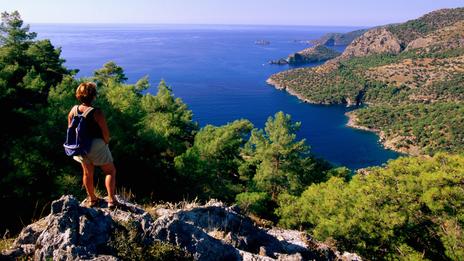 A hiker climbs the coastline between Kayakoy and Oludeniz. (John Elk III/Getty)
A hiker climbs the coastline between Kayakoy and Oludeniz. (John Elk III/Getty) Formerly known as Levissi, Kayakoy was a thriving community of some 10,000 until the early 1920s. Both Anatolian Muslims and Greek Orthodox Christians had lived here in harmony since its origins in the 14th Century. The Muslims, who lived on the surrounding valley floor of the Kaya (“Rock”) Valley, tended to be farmers, while the Christians, who inhabited the hillside, were mostly artisans; the two communities were closely linked by trade and helped each other in times of need. Christian and Muslim women exchanged food and sweets at weddings and religious festivities; Muslim musicians played at Orthodox festivities and took part in wrestling matches during Easter celebrations; children played together in the lanes; and men of both religions congregated at local cafés, fingering their worry beads, smoking water pipes and playing backgammon.
But in 1923, at the conclusion of the Greco-Turkish War of 1919-1923, Kayakoy was suddenly emptied of its 6,500 Christian inhabitants: both Turkey’s Christian citizens and Greece’s Muslims were expulsed from their homes in a population exchange meant to ensure that each country had only one main religion. Levissi became known as Kayakoy, or Rock Village.
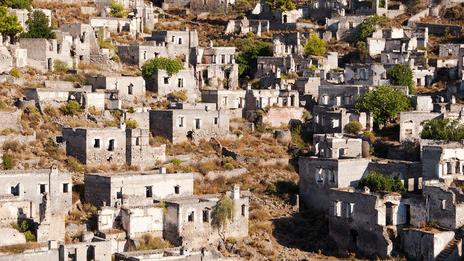 Today, Kayakoy is a skeleton of its former self. (Paul Biris/Getty)
Today, Kayakoy is a skeleton of its former self. (Paul Biris/Getty) Naci Dinçer, a resident of nearby Fethiye whose father was five when his family was cast out from Thrace in eastern Greece, chatted with me in his office across from Paşa Kebab, Fethiye’s best-loved kebab restaurant. With his snow-white hair and rosy cheeks, Dinçer could pass for St Nicholas, who was born in nearby Patara. “Their Muslim neighbours didn’t want their friends to leave,” Dinçer said about the deportations. “They even sent an appeal to the government in Ankara, but the government refused.”
When the dispossessed arrived in Greece, many wandered in search of a place they could call home. Those deported from Kayakoy and Fethiye eventually settled on a scenic spot 40km northeast of Athens, selecting it for its resemblance to their lost home. Meanwhile, the Muslim farmers exiled from Greece found the land in Kayakoy inhospitable and soon decamped, leaving the hillside village abandoned for a second time. In 1957, a 7.1 magnitude earthquake delivered Kayakoy its final coup de grâce, destroying most of the town’s buildings. Homes and businesses around the valley floor were later restored or rebuilt, but the hillside homes and buildings have been left untouched.
Today, the hillside of Kayakoy remains deserted, never having recovered – either culturally or economically – from the mass exodus in 1923. The homes, schools, shops, cafés, chapels and churches have been left to crumble like feta, unprotected from looters or the elements. Mercifully, the Turkish Ministry of Culture rescued the hillside from mass development by granting it museum status a few years ago.
Now, scrambling around the hushed ruins, I entered the shell of a house that had only the sky for a roof and weeds for a floor. I stepped into what must have been the kitchen, running my fingers over the swath of salmon pink paint still colouring a crumbling wall. When a piece cracked off, I felt ashamed, an intruder in the family’s grief.
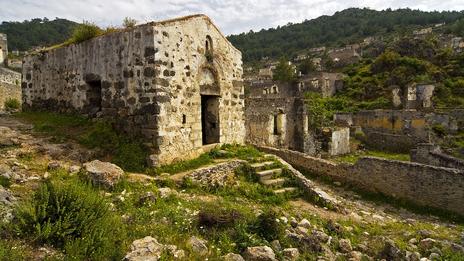 An abandoned Kayakoy chapel. (Ihsanyildizli/Getty)
An abandoned Kayakoy chapel. (Ihsanyildizli/Getty) The poignancy of the community’s absence is most palpable in the remains of the Kato Panagia, the town’s Lower Church. Its faded frescoes, vaulted ceilings and multi-arched forecourt evoke the church’s former glory, but looters and the elements have not treated it kindly. Still, with a little imagination, it was easy to picture the church and the village in happier times, when incense burned, the priest intoned, villagers gathered to celebrate christenings, marriages and feast days – and Muslim and Christian residents lived side by side. “Kaya Village is a symbol of peace and harmony,” said Dinçer, who travels all over Greece and Turkey to meet deportees and their descendants.
At the same time, the ghost town of Kayakoy is a bittersweet reminder of the fragility of harmony between cultures – and in many ways, of the fragility of existence itself.
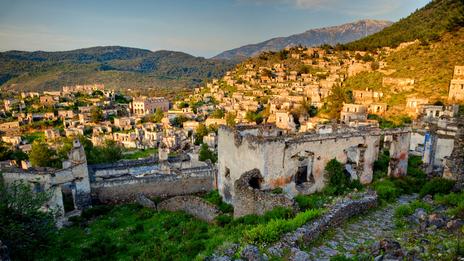 More than a mere ghost town, Kayakoy is a reminder of harmonious times. (Ron Watts/Getty)
More than a mere ghost town, Kayakoy is a reminder of harmonious times. (Ron Watts/Getty) Practicalities
The nearest airport is Dalaman Airport, 60km northwest. The best time to travel to Kayakoy is in the spring or autumn, when it is not too hot; at the height of summer, visit during the evening, when it is cooler and most day trippers have left. At night the village is lit up, adding to the ghostly effect.
There are hundreds of hotels and pansyons, or pensions, around Hisaronu and Oludeniz, but if getting some shut-eye is important, avoid Hisaronu, which is known for its nightlife. In Oludeniz, the beachfront Jade Residence has 10 rooms and apartments, an olive tree garden and a luxurious pool. Or you can stay in Kayakoy at the Misafir Evi, located on the inhabited valley floor just off the main road, which has nine comfortable double rooms with balconies or patios.
There are several restaurants in the inhabited section of the town. Try Levissi Garden, located in an old three-storey stone building with views of the ghost town and an impressive wine cellar. The restaurant offers a shuttle service from local hotels.
Dolmuses (mini buses) from the towns of Fethiye, Ölüdeniz and Hisaronu run to Kayakoy every 30 to 60 minutes. From the Fethiye bus station, the trip takes 45 minutes via Ovacik and Hisaronu. Look for the dolmus with the card in the front window that says Kaya Village. Tickets range from three Turkish lira to six Turkish lira, depending on your starting point.
Admission fee to the abandoned village is five Turkish lira, and the ticket booth is beside the Lower Church. More information can be found at Kayakoy’s tourism website.

